The new year has just begun and we have six weeks left before the final release! The most noticeable change since my last post is obviously that we have decided on the wallpaper to be used in Plasma 6.0! But of course there’s more going on under the hood than just that.
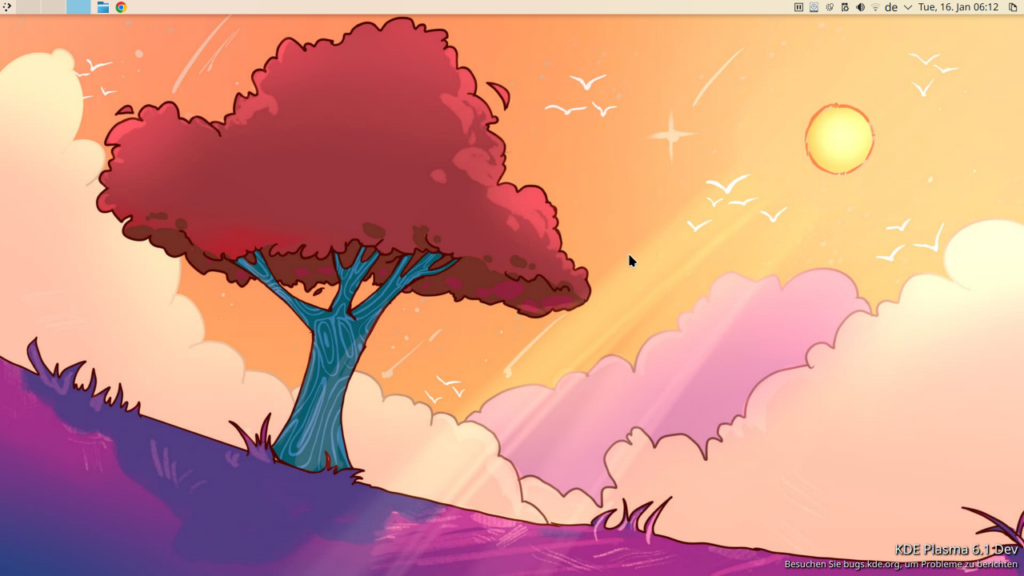
I actually spent most of my time in Qt Wayland rather than KDE code lately but more on that in an upcoming blog post once all my changes have been integrated. Nevertheless, there are still plenty of Wayland-related and other improvements on the Plasma, Frameworks, and KDE Gear side to talk about here.
XDG Foreign Everywhere
After my previous experience of revamping the KWin Window Killer and having learned how to use the XDG Foreign Protocol (a Wayland protocol for exporting a surface to enable a different process to attach to it), I looked at all the places we have a helper application show a window in another application. This is actually done a lot more often than I thought and thus I added API in KWindowSystem for both exporting and importing windows on Wayland.
Since the export side is only really needed on Wayland, I added (un)exportWindow(QWindow*) functions in KWaylandExtras (a utility namespace with Wayland-specific windowing system functionality) along with a windowExported signal once that has been performed. Setting a foreign parent windows can already be done by using KWindowSystem::setMainWindow or even just QWindow::fromWinId. Both of them take a WId (a long int usually) which means that a string-based handle received from the compositor doesn’t play well with the existing APIs.
In case of KWindowSystem I just added a QString overload. The clever part is that it also understands a long int in a string, thus you just feed a token received as a string from QCommandLineParser or stdin verbatim into the API (even supports using 0x and 0b prefixes) and have it do the right thing on all platforms. That way you only have to special-case the export part for Wayland but the importing side will “just work”. Lifetime of the objects is tied to the actual window and there’s no additional resource tracking logic needed on the application side besides calling those functions, pretty neat.
Both kdialog and keditfiletype support XDG Foreign handles for their relevant attach/parent argument now. It is important to have all “public” command-line tools adjusted for 6.0, thereby knowing it’s a Qt 6 build is enough to tell whether it will understand the string or refuse to start on being unable to parse it as a number. If you know of any other tools that might need adjustment, please do tell. The KAuth Framework for executing privileged tasks as well as the KDE PolicyKit agent also learned how to create and understand those handles. This ensures the password prompt is attached to the window it came from (e.g. when changing settings). There’s still plenty of places where KAuth is used without setting a parent window on the executed action but at least the infrastructure is all there now.
More fractional scaling goodness
Of course I accomplished a few more fixes for fractional scaling. The pixmap created by Item.grabToImage now captures it with the proper scale factor. I also made a fix for then using that grab result in a Drag handler (not merged yet). Together with another fix for Plasma’s Folder View and a KWin change I did a while ago we should finally have crisp pixmaps when dragging icons on the desktop. That was a lot more entangled than I anticipated with the scale factor discarded at pretty much every opportunity along the way.

TextInput and TextEdit also re-render themselves immediately when the scale factor changes. This fixes sticky notes on the desktop being blurry until interacted with as well as spin boxes and other editable controls in apps like System Settings. The issue was addressed for labels some time ago but similar treatment was needed for input fields, too.
I talked about Dolphin’s icon rendering in September and now file thumbnails are properly rendered with fractional scaling, too, both in the main file view and the information sidebar. Méven Car worked on high-dpi support for thumbnailers previously and the switch to Frameworks 6 was a good opportunity to change the wire-format used for communication between app and thumbnailer to use a floating-point number for the scale factor instead of an integer. While at it, I also fixed the “tick” icon to accept input on the address bar. Furthermore, mouse cursor theme previews in System Settings are also scaled smoothly. Incidentally, KWin’s bouncing cursor (startup feedback) is scaled according to the cursor size on Wayland, too.
Speaking of Dolphin, the Places sidebar no longer lets you drag one place into another one. While I found that Windows also lets you do that (macOS doesn’t), I don’t really see the point, unless you want to drag your Documents folder to an external hard drive directly? More importantly, though, it makes re-arranging places very finicky since the drop area in-between places is very small. Obviously, it is still possible to drag files and folders from the main view and elsewhere onto an entry in the Places panel to copy/move/link it to the folder or hard drive in question.
In order to fix KWin’s screen edge triggering inadvertently while selecting text in an application and nudging the corner of the screen, I disabled them completely when a mouse cursor is pressed. However, I wasn’t entirely happy with this (and people in the comments weren’t either) and now it’s possible to drag a file into a screen edge and peek at the desktop to drop it there. Making the new overview effects work with drag and drop is going to be a lot more work, so it’s left for a later time. I’d also love to be able to switch virtual desktops while dragging a file, just like we do when touching the screen edge while dragging a window.
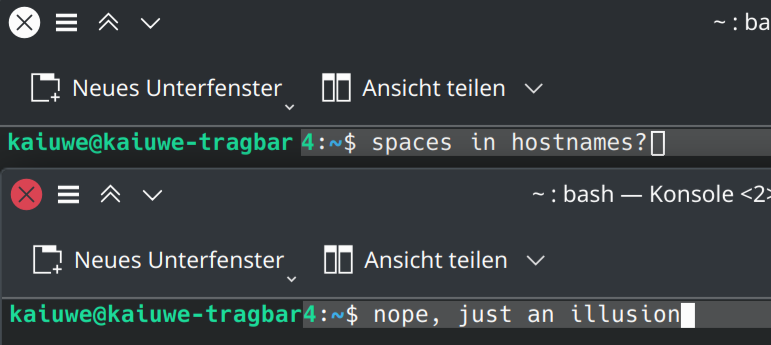
On the subject of broken rendering, I also found a way to improve font rendering in Konsole after the removal of QFont::ForceIntegerMetrics in Qt 6. From what I can tell Konsole entirely relies on the fact that all characters are the same width. Apparently, even with a Monospace font under certain conditions thanks to Hinting and Kerning this may not be entirely the case. Forcing full hinting on the font used seems to ensure that no such trickery is going on. If you still see broken fonts when text is highlighted or selecting it, check that your distribution doesn’t force any particular font settings here.
Anything else
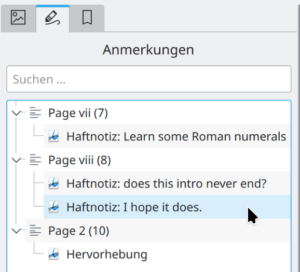
As a heavy user of Okular’s fantastic annotation feature where you can add labels, sticky notes, shapes, lines, and all sorts of other markers to a (PDF) document, I slightly improved the Annotation sidebar: Custom page numbers are now displayed (pages in a PDF aren’t necessarily strictly numbered but there can be Roman numerals for the index, for example, just like in a real book) and the textual content of the annotation, if any, is shown as well to more easily identify which item is which.
Libksysguard learned SI prefixes for Ampere, Volt, Watt, and Watt-hour units. Should I ever upgrade to a Petawatt solar installation, System Monitor has got me covered. KMessageDialog gained a beep function for playing the relevant notification sound (warning, error, etc), for applications that implement a custom message box and already depend on KWidgetsAddons but don’t want to pull in KNotification just for this. It is now used by Kate’s “Save?” dialog which looks like a message box when saving a single file but because it may also display a list of files is a custom implementation. I also had a look at how to make Qt’s own QMessageBox play the KDE sounds but this is routed though the Qt accessibility framework and I wasn’t sure how to hook into that without jeopardizing more important components of it like the AT-SPI interface.
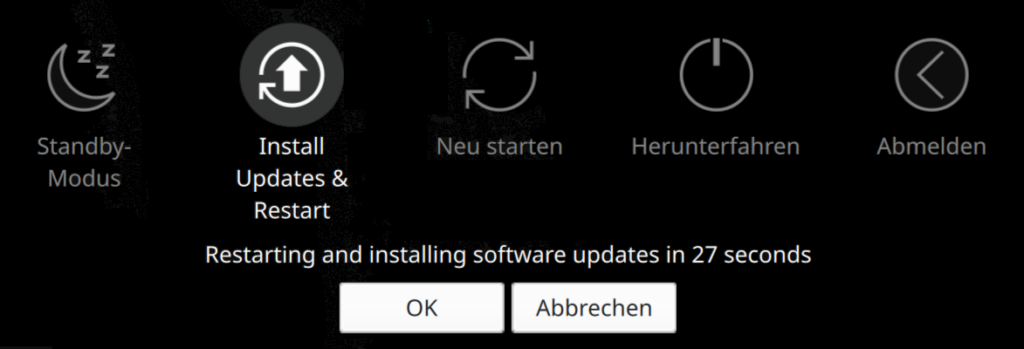
With the prevalence of Offline Updates (i.e. restarting the system and installing updates in a minimal environment) there’s now a dedicated “Reboot & Install Updates” button on the logout screen to skip installing updates and just reboot. This could surely be extended in the future, e.g. shut down without installing updates or install them now instead of on next boot and so on but at least you can now easily reboot the system without installing updates if you want to.

Finally, even though we’re all busy squashing any remaining bugs for the 6.0 release, it has been branched off into the “stable” release branch and the repositories are again open for gentle feature development (which includes anything that needs new translations). I just merged a tiny change exclusive to Plasma 6.1: displaying the WiFi channel number next to its frequency in connection details.
Discuss this post on KDE Discuss.
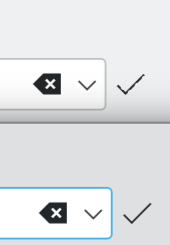
I’m amazed, you are a star!
Thank you for fractional scaling fixes!
Great improvements!
Cool that you now not allow to drag one place into another.
I was always wasting time to be careful when I rearranged them to my preference to not drop them one into another.
Good job on the text rendering improvements, they are always welcomed!
And our eyes are thankful for that.
And great to see more info in the Wifi widget such as the channel number.
I assume the channel width is not possible or there’s not more space where to display it.
BTW, please try it with IWD too!
I’ve been using IWD for 2-3 years and unfortunately this field is not nice to look at:
Security type: Unknown security type
If it’s a problem in IWD itself I’m sure they will fix it if it’s on their side.
Thank you very much!
Thanks for the improvements.
About this:
https://blog.broulik.de/wp-content/uploads/2023/11/Screenshot_20231020_102818.png
There should be more space between the dropdown and the checkmark. This is a common theme in KDE where you guys don’t know about or seem unable to follow typical design patterns and principles when it comes to proportions and item spacing. I really hope you get those small things fixed :)
Thank you very much.
If by typical design patterns you mean enormous touch-focussed UIs that cannot be used on a regular laptop screen anymore because it uses ample whitespace (breating space, lol), then I am glad we don’t do that.
That being said, I’ve wanted to rework the address bar somewhat to make it more obvious that it is editable, there I’ll probably touch the code painting the tick as well.
“Speaking of Dolphin, the Places sidebar no longer lets you drag one place into another one.”
Wonderful! That one really worried me when I set up a system for a user hoping they didn’t inadvertently move things where they shouldn’t go.